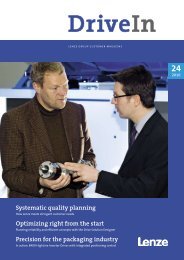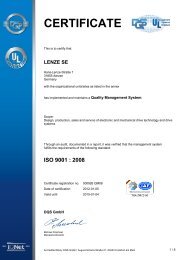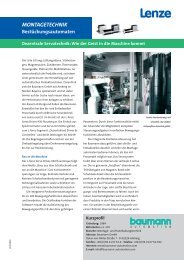Trade fairs - Lenze
Trade fairs - Lenze
Trade fairs - Lenze
You also want an ePaper? Increase the reach of your titles
YUMPU automatically turns print PDFs into web optimized ePapers that Google loves.
Zinc, not rust<br />
<strong>Lenze</strong> technology gets things moving in a hot dip simulator<br />
Steelworks and research institutions are<br />
constantly exploring more effective<br />
processes and new alloys in order to galvanise<br />
steel more effectively. For this<br />
purpose many of them use hot dip simulators<br />
made by the Japanese company<br />
Iwatani. These systems, which incorporate<br />
<strong>Lenze</strong> servo technology, allow production<br />
processes to be simulated with<br />
high precision. This helps prevent nasty<br />
surprises when moving from the laboratory<br />
to full-scale production.<br />
The Iwatani hot dip process simulator<br />
reproduces the entire sheet galvanising<br />
process in a small space. This includes<br />
cleaning the metal by heating it in a<br />
hydrogen-nitrogen atmosphere before<br />
dipping. <strong>Lenze</strong> servo technology takes<br />
care of the movement processes within<br />
the system, which was supplied by the<br />
engineering specialists at Falk Steuerungssysteme<br />
GmbH, Stadthagen.<br />
The hot dip simulator makes use of a<br />
9300 Servo PLC series user-programmable<br />
servo inverter. This inverter controls an<br />
MCS series synchronous servo motor, a<br />
little powerhouse which in turn drives a<br />
recirculating ball screw via a toothed<br />
belt. This ball screw takes the metal<br />
sample vertically through the various<br />
zones of the machine. The processes<br />
performed in these zones include heating<br />
the metal by infrared or induction,<br />
and cooling it down after galvanisation.<br />
The 12 x 20 cm metal sample is<br />
dipped at high speed into the zinc bath,<br />
and remains there for only a short time.<br />
It is then removed again in only 120 milliseconds.<br />
“This involves an acceleration<br />
The hot dip process simulator reproduces<br />
large-scale production processes<br />
with great precision.<br />
of 25 m/s2 , which would not be possible<br />
without tough, powerful servo motors.<br />
They’re extremely quick,”explains Martin<br />
Falk, proprietor of the engineering company.<br />
The process makes use of the<br />
entire overload capacity of the motor.<br />
This high speed is necessary in order<br />
to avoid what is known as the “fir-tree<br />
effect” during hot dip galvanising, since<br />
this would distort the laboratory results<br />
enormously. The longer the metal plate<br />
remains in the molten zinc, the thicker<br />
the coating becomes. So if the sample<br />
was dipped slowly into the liquid metal,<br />
it would end up with a much thicker<br />
coating of zinc at the bottom than at<br />
the top. This effect does not actually<br />
occur in practice during sheet metal galvanisation,<br />
since the sheet steel passes<br />
In action<br />
through the zinc bath continuously, and<br />
any given point remains immersed for<br />
the same amount of time.<br />
The way in which the metal sample<br />
touches down onto the surface of the<br />
liquid zinc is crucial to prevent the 460<br />
degrees Celsius molten metal from<br />
splashing. The touch-down position can<br />
be measured using a current sensor. The<br />
measured data is collected via the<br />
inverter and via external subassemblies.<br />
The 9300 Servo PLC is part of a control<br />
assembly consisting of an industrial PC<br />
with a bus connection, and non-central<br />
components. The industrial PC can be<br />
used to precisely define all of the parameters<br />
of the machine such as gas<br />
mixture, temperature zones and times.<br />
This enables product and process<br />
improvements to be simulated at a lost<br />
cost, since very little material is used<br />
and valuable test production capacities<br />
are preserved.<br />
Hard alloys<br />
Steel is everywhere, be it in the form of<br />
cars, bridges or high-rise buildings.<br />
This universal material does, however,<br />
have one great weakness: it rusts. Hot<br />
dip galvanising offers the best protection<br />
against rust. It involves immersing<br />
the steel in zinc heated to more than<br />
450 degrees Celsius. Whilst in this<br />
zinc bath, a metallurgical reaction<br />
takes place, and the resulting iron-zinc<br />
alloy layers are highly durable. Treated<br />
this way, steel is protected against corrosion<br />
for decades, and the protective<br />
coating can resist even severe physical<br />
wear.<br />
15












